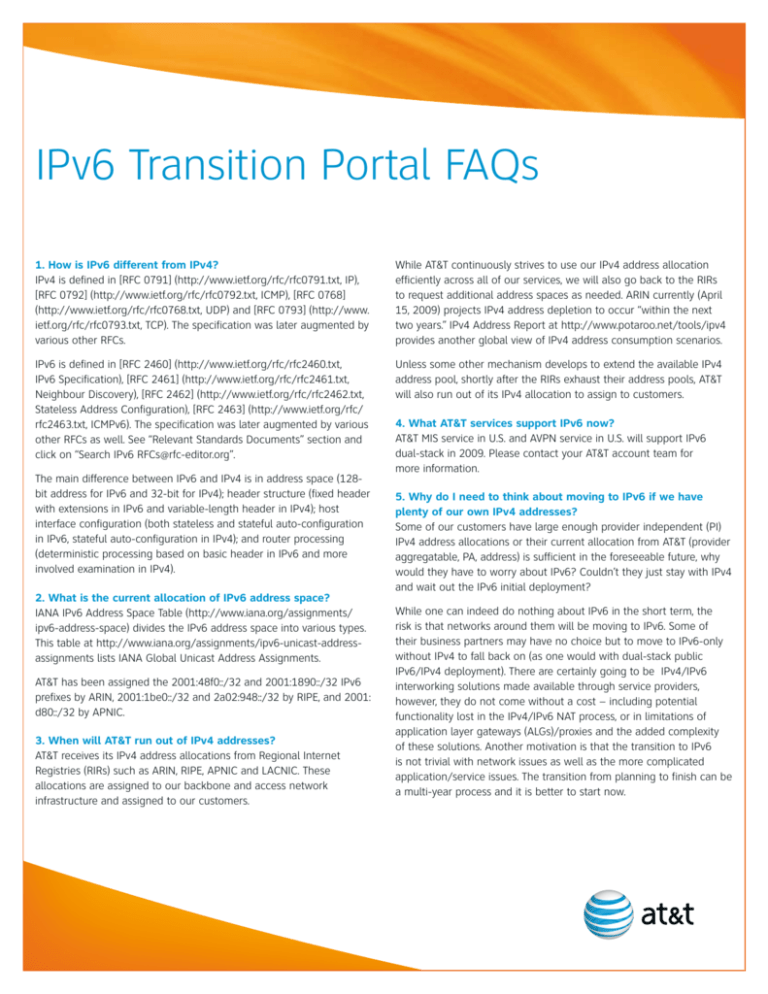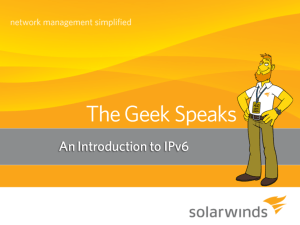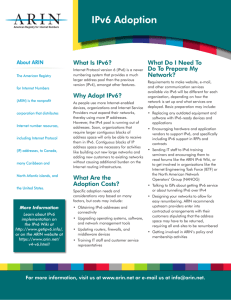
IPv6 Transition Portal FAQs
1. How is IPv6 different from IPv4?
IPv4 is defined in [RFC 0791] (http://www.ietf.org/rfc/rfc0791.txt, IP),
[RFC 0792] (http://www.ietf.org/rfc/rfc0792.txt, ICMP), [RFC 0768]
(http://www.ietf.org/rfc/rfc0768.txt, UDP) and [RFC 0793] (http://www.
ietf.org/rfc/rfc0793.txt, TCP). The specification was later augmented by
various other RFCs.
While AT&T continuously strives to use our IPv4 address allocation
efficiently across all of our services, we will also go back to the RIRs
to request additional address spaces as needed. ARIN currently (April
15, 2009) projects IPv4 address depletion to occur “within the next
two years.” IPv4 Address Report at http://www.potaroo.net/tools/ipv4
provides another global view of IPv4 address consumption scenarios.
IPv6 is defined in [RFC 2460] (http://www.ietf.org/rfc/rfc2460.txt,
IPv6 Specification), [RFC 2461] (http://www.ietf.org/rfc/rfc2461.txt,
Neighbour Discovery), [RFC 2462] (http://www.ietf.org/rfc/rfc2462.txt,
Stateless Address Configuration), [RFC 2463] (http://www.ietf.org/rfc/
rfc2463.txt, ICMPv6). The specification was later augmented by various
other RFCs as well. See “Relevant Standards Documents” section and
click on “Search IPv6 RFCs@rfc-editor.org”.
Unless some other mechanism develops to extend the available IPv4
address pool, shortly after the RIRs exhaust their address pools, AT&T
will also run out of its IPv4 allocation to assign to customers.
The main difference between IPv6 and IPv4 is in address space (128bit address for IPv6 and 32-bit for IPv4); header structure (fixed header
with extensions in IPv6 and variable-length header in IPv4); host
interface configuration (both stateless and stateful auto-configuration
in IPv6, stateful auto-configuration in IPv4); and router processing
(deterministic processing based on basic header in IPv6 and more
involved examination in IPv4).
2. What is the current allocation of IPv6 address space?
IANA IPv6 Address Space Table (http://www.iana.org/assignments/
ipv6-address-space) divides the IPv6 address space into various types.
This table at http://www.iana.org/assignments/ipv6-unicast-addressassignments lists IANA Global Unicast Address Assignments.
AT&T has been assigned the 2001:48f0::/32 and 2001:1890::/32 IPv6
prefixes by ARIN, 2001:1be0::/32 and 2a02:948::/32 by RIPE, and 2001:
d80::/32 by APNIC.
3. When will AT&T run out of IPv4 addresses?
AT&T receives its IPv4 address allocations from Regional Internet
Registries (RIRs) such as ARIN, RIPE, APNIC and LACNIC. These
allocations are assigned to our backbone and access network
infrastructure and assigned to our customers.
4. What AT&T services support IPv6 now?
AT&T MIS service in U.S. and AVPN service in U.S. will support IPv6
dual-stack in 2009. Please contact your AT&T account team for
more information.
5. Why do I need to think about moving to IPv6 if we have
plenty of our own IPv4 addresses?
Some of our customers have large enough provider independent (PI)
IPv4 address allocations or their current allocation from AT&T (provider
aggregatable, PA, address) is sufficient in the foreseeable future, why
would they have to worry about IPv6? Couldn’t they just stay with IPv4
and wait out the IPv6 initial deployment?
While one can indeed do nothing about IPv6 in the short term, the
risk is that networks around them will be moving to IPv6. Some of
their business partners may have no choice but to move to IPv6-only
without IPv4 to fall back on (as one would with dual-stack public
IPv6/IPv4 deployment). There are certainly going to be IPv4/IPv6
interworking solutions made available through service providers,
however, they do not come without a cost – including potential
functionality lost in the IPv4/IPv6 NAT process, or in limitations of
application layer gateways (ALGs)/proxies and the added complexity
of these solutions. Another motivation is that the transition to IPv6
is not trivial with network issues as well as the more complicated
application/service issues. The transition from planning to finish can be
a multi-year process and it is better to start now.
IPv6 Transition Portal FAQs___________________________________________________________________________________________________________________ 6. We manage our own VPN on top of AT&T MIS service, what
do we have to do when we get IPv6 connectivity from AT&T?
When you order new dual-stack circuits for your new locations, no
action would initially need to be taken since the new sites will also have
IPv4 connectivity and your existing VPN solution will continue to work.
7. We hear a lot about various tunneling schemes (Teredo, etc.),
do we need them?
Just as in IPv4 where tunnels serve to deliver payload over incompatible
or differently administered network infrastructure, tunnels with IPv6
can connect islands of IPv6 across IPv4 network, or islands of IPv4
across IPv6 network.
For connecting IPv6 islands over public IPv4 network, simple tunneling
mechanisms such as GRE, 6to4 (RFC 3056) and static tunnels (RFC
4213) can be used. These are supported by many routers.
There are also proposals to connect IPv4 islands across IPv6, when
IPv6 deployment is more widespread. Softwire Mesh (I-D.softwiremesh-framework) is one such candidate that was recently approved as
a Proposed Standard.
Teredo (RFC 4380), Tunnel Broker (RFC3053 and I-D.tunnelbroker-tsp)
and Softwire Hub-and-Spoke (I-D.softwire-hs-framework-l2tpv2) are
proposals that allow individual IPv6 capable hosts to communicate
across IPv4 networks with the help of agents in the network.
8. We manage our own CPE attached to MIS circuit, what do I
need to do differently with IPv6?
Routing Protocols: MIS service supports CPE routers with static routes
or running BGPv4.
Multi-homing: If the customer has IPv6 PI address prefix (/48 and
shorter), the prefix can be announced towards AT&T’s backbone. The
customer is responsible for arranging and announcing the prefix to
any other network providers and the correct forwarding behavior
of its internal network. If only PA addresses are used, the customer
is expected to obtain separate IPv6 PA prefixes from each of the
providers including AT&T and have the internal network and hosts
make correct address selection and packet forwarding decisions.
Firewall/ACLs: Customer needs to ensure that firewall device can
process IPv6 packets and tunneled IPv6 packets, and set it up to allow
IPv6 traffic with IPv6 specific rules.
9. What do we need to do to DNS servers and records when we
move to IPv6?
Host records: one could try to avoid service disruption by configuring
and announcing IPv6 specific names for servers and services that will
be available on IPv6 as well as IPv4. For example, ‘www.ipv6.example.
com’ and ‘www.example.com’ may point to the same physical server
but one would resolve to an ‘AAAA’ record with IPv6 address while the
other would resolve to an ‘A’ record as it does today.
Resolvers: AT&T resolvers are being updated to support requests via
IPv6 addresses and ‘AAAA’ records. AT&T’s DNS provisioning tool will in
the future support both IPv4 and IPv6.
Other topics such as zone definitions and zone transfer considerations
will be addressed in the future.
10. We have site-to-site IPsec connections with some of our
business partners, what would need to happen when we go IPv6?
If a customer moves from an IPv4 MIS connection to IPv4/IPv6
dual-stack connection, no additional action is needed to keep the IPv4
site-to-site IPsec connection with a business partner.
However, this assumes that the customer either does not deploy
IPv6 internally or that the deployment does not interrupt the normal
business traffic between the partners. For example, a dual-stack host
at the site will correctly select IPv4 interface addresses to communicate
with a partner’s host (on IPv4 network).
If the partners intend for IPv6 and IPv4 traffic to flow over the private
VPN connection, additional work to ensure either both sites have IPv6
connectivity and IPv6 VPN solution is available, or that both sites can
support IPv6 traffic tunneled over IPv4 VPN.
11. Can I use my own IPv6 allocation with AT&T IPv6 services?
AT&T’s current policy related to PI addresses for MIS IPv6 service is
that we minimally require a /48 PI prefix to be provided to AT&T for
announcement to our peers. The /48 can be divided among multiple
attachment points to the MIS IPv6 network as long as each location
has a minimum /64 prefix.
12. I have AT&T managed CPE for my MIS service, how should I
configure my end hosts for IPv6?
Currently, LAN hosts will need to be manually configured with the correct
IPv6 parameters, unless the customer deploys an internal DHCPv6
server. The AT&T managed CPE router does not have SLAAC configuration
and/or DHCPv6 relay agent configuration support at this time.
13. What is AT&T’s IPv6 address assignment policy? How long a
prefix can a customer get?
Customer LAN blocks will follow ARIN regulations with a /56 subnet
being assigned as the default per customer location. The customer
can request up to a /48 prefix without providing any additional
documentation. To receive multiple /48 prefixes the customer will
need to document the request according to ARIN requirements.
14. Does the AT&T IPv6 network support multicast?
AT&T’s initial (current) release of IPv6 service (MIS and AVPN) does not
support multicast in the IPv6 network.
15. What will happen when IPv4 addresses run out?
AT&T has programs to efficiently manage its IPv4 addresses to meet
customers’ continued need for it. However, there will come a time
when AT&T cannot assign additional IPv4 address to an existing
customer or a new customer.
There are various strategies and proposals to delay the exhaustion
of IPv4 address. Some are considering the techniques on the carriergrade NAT theme; others the techniques around IPv4/IPv6 NAT. Still
some speculate that a post-RIR-IPv4-Address-Exhaustion market place
will emerge where IPv4 address blocks may be bought and sold.
IPv6 Transition Portal FAQs___________________________________________________________________________________________________________________ 16. What are some of the IPv6 resources?
a. Internet Society (ISOC) IPv6 Page (http://www.isoc.org/educpillar/
resources/ipv6.shtml)
b. ARIN’s IPv6 Wiki (http://www.getipv6.info)
c. Search IPv6 RFCs (http://www.rfc-editor.org/cgi-bin/rfcsearch.pl?sear
chwords=ipv6&opt=title&num=250&filefmt=txt)
g. IPv6 Portal (http://www.ipv6tf.org)
h. IETF Behave Working Group (http://tools.ietf.org/wg/behave/)
i. IETF Softwire Working Group (http://tools.ietf.org/wg/softwire/)
j. IETF V6ops Working Group (http://tools.ietf.org/wg/v6ops/)
d. Hexago’s IPv6 site (http://www.go6.net)
e. IPv6Forum site (http://www.ipv6forum.com)
f. IPv4/IPv6 Co-existence Information (http://www.civil-tongue.net/
6and4/wiki)
For more information contact your AT&T Representative or visit us at www.att.com/business.
05/13/09 AB-1609
© 2009 AT&T Intellectual Property. All rights reserved. AT&T and the AT&T logo are trademarks of AT&T Intellectual Property.






